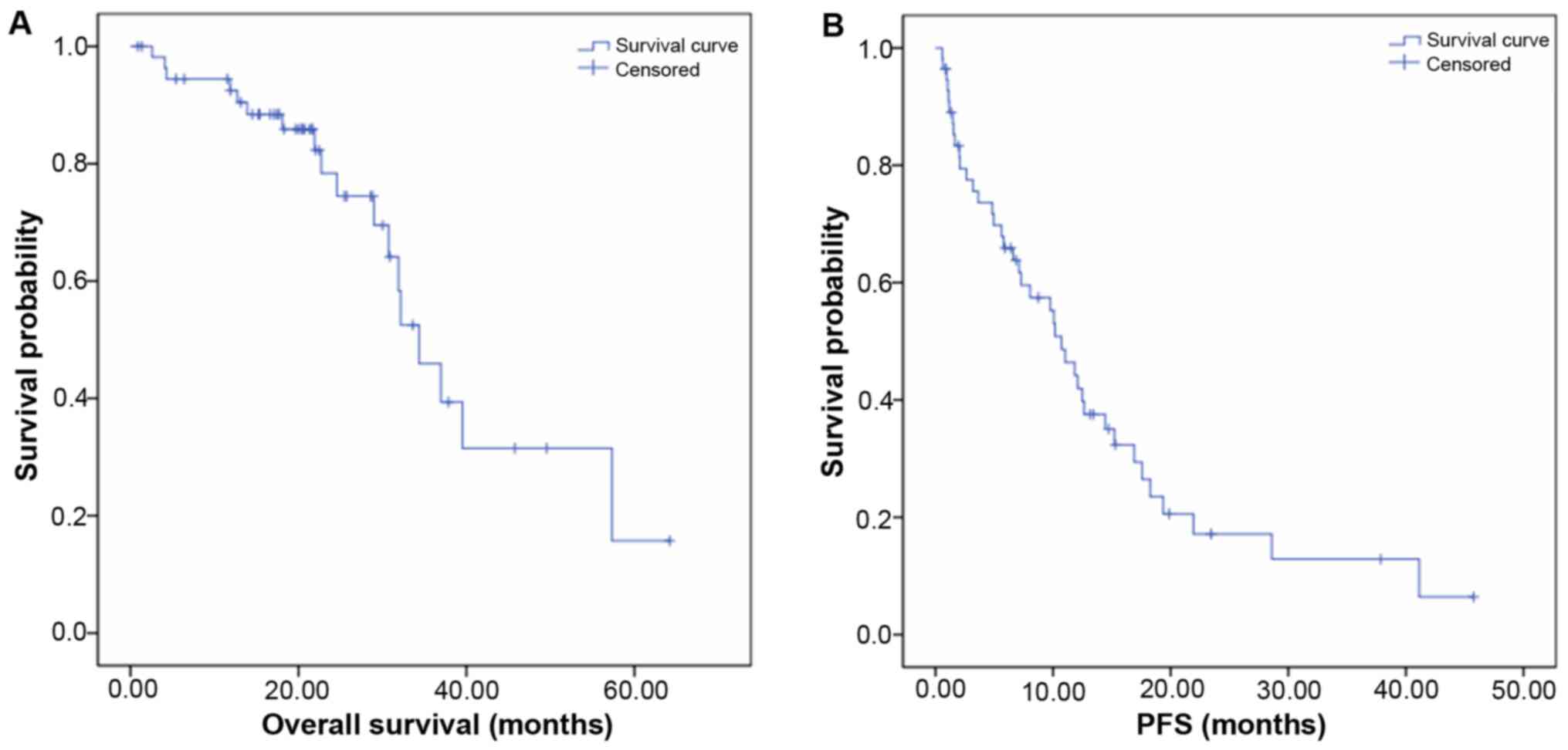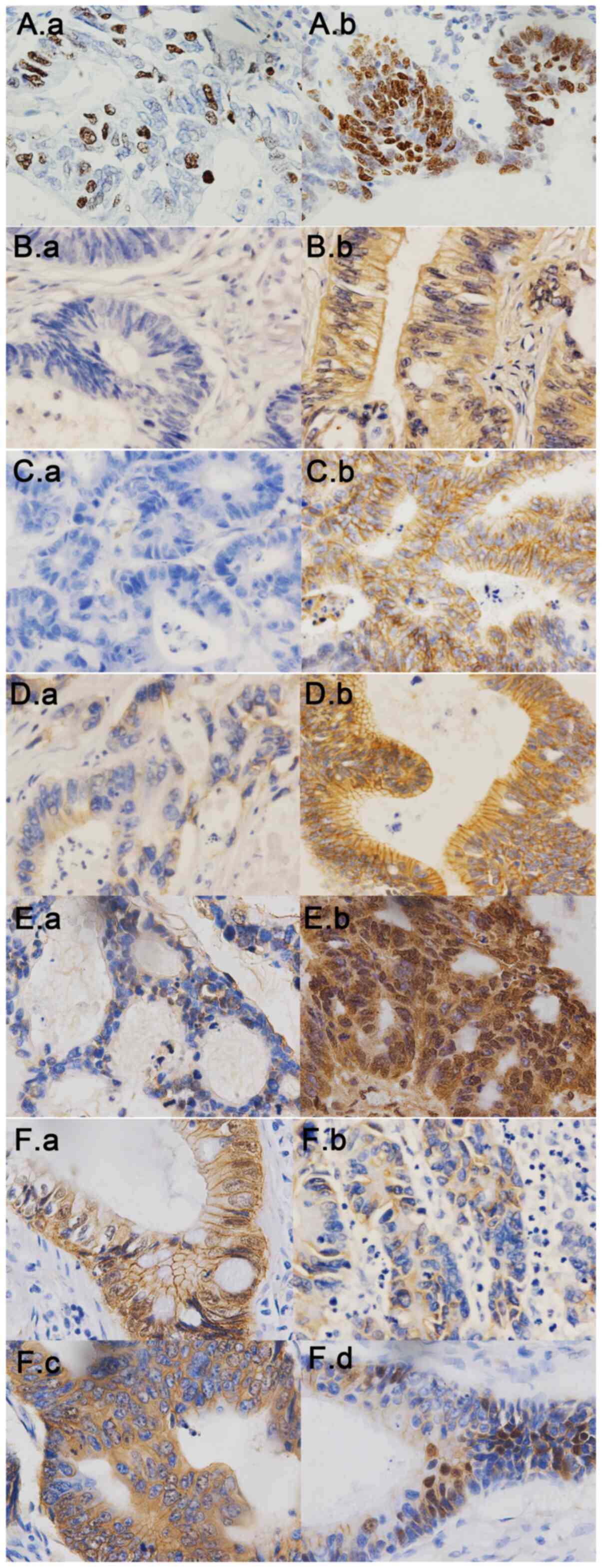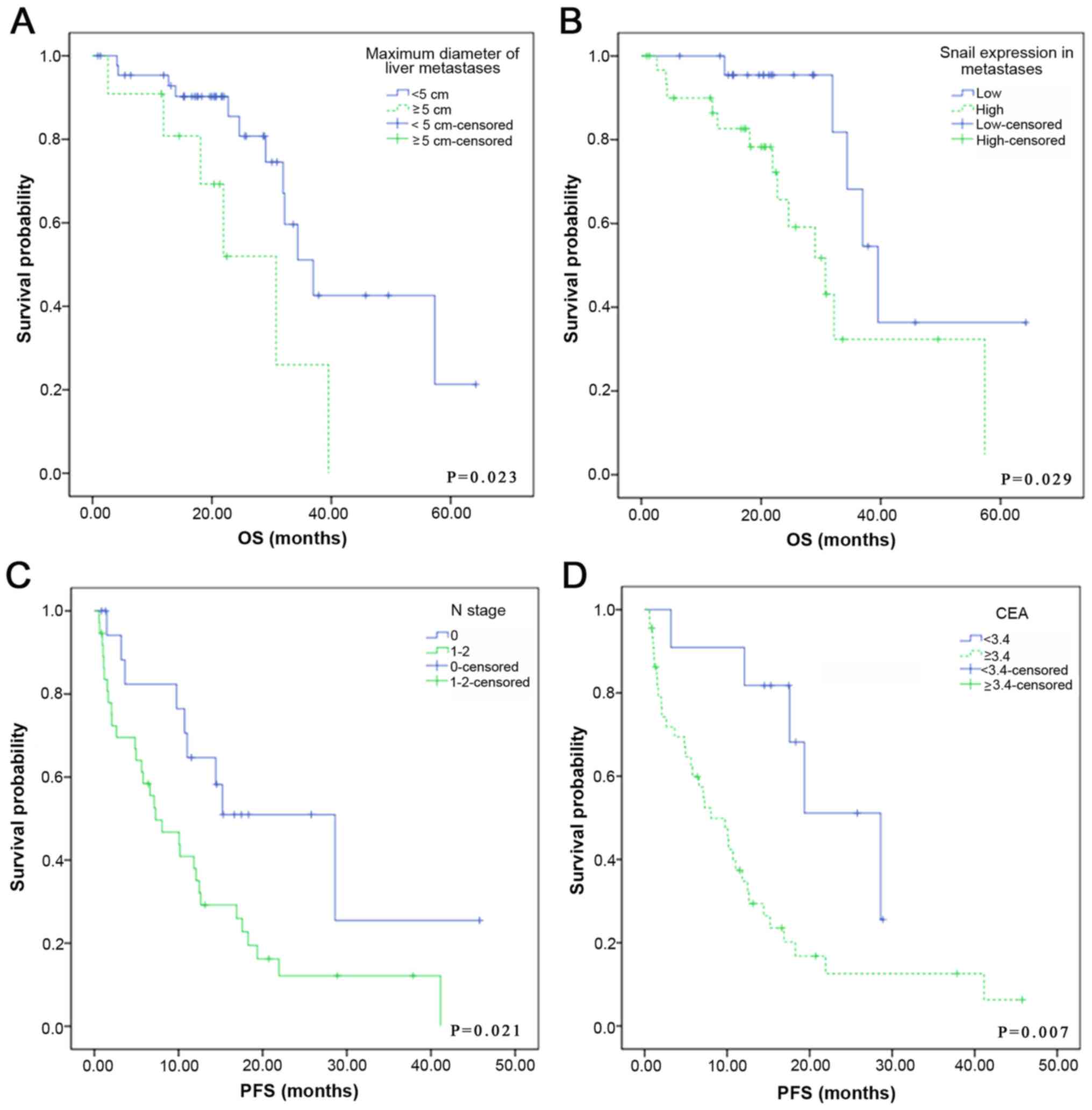|
1
|
Stewart BW and Wild CP: World Cancer
Report 2014. World Health Organization; 2014
|
|
2
|
Chen WQ, Zheng RS and Zhang SW: Report of
Cancer Incidence and Mortality in China, 2012. China Cancer.
25:1–8. 2016.PubMed/NCBI
|
|
3
|
Garden OJ, Rees M, Poston GJ, Mirza D,
Saunders M, Ledermann J, Primrose JN and Parks RW: Guidelines for
resection of colorectal cancer liver metastases. Gut. 55 (Suppl
3):iii1–iii8. 2006. View Article : Google Scholar : PubMed/NCBI
|
|
4
|
De Greef K, Rolfo C, Russo A, Chapelle T,
Bronte G, Passiglia F, Coelho A, Papadimitriou K and Peeters M:
Multisciplinary management of patients with liver metastasis from
colorectal cancer. World J Gastroenterol. 22:7215–7225. 2016.
View Article : Google Scholar : PubMed/NCBI
|
|
5
|
Choti MA, Sitzmann JV, Tiburi MF,
Sumetchotimetha W, Rangsin R, Schulick RD, Lillemoe KD, Yeo CJ and
Cameron JL: Trends in long-term survival following liver resection
for hepatic colorectal metastases. Ann Surg. 235:759–766. 2002.
View Article : Google Scholar : PubMed/NCBI
|
|
6
|
Brouquet A, Abdalla EK, Kopetz S, Garrett
CR, Overman MJ, Eng C, Andreou A, Loyer EM, Madoff DC, Curley SA,
et al: High survival rate after two-stage resection of advanced
colorectal liver metastases: Response-based selection and complete
resection define outcome. J Clin Oncol. 29:1083–1090. 2011.
View Article : Google Scholar : PubMed/NCBI
|
|
7
|
Yan X, Wang K, Wang Q, et al: Prognostic
evaluation of clinical scoring systems for patients undergoing
resection of colorectal cancer liver metastases. Chin J
Hepatobiliary Surg. 21:388–392. 2015.PubMed/NCBI
|
|
8
|
Spelt L, Andersson B, Nilsson J and
Andersson R: Prognostic models for outcome following liver
resection for colorectal cancer metastases: A systematic review.
Eur J Surg Oncol. 38:16–24. 2012. View Article : Google Scholar : PubMed/NCBI
|
|
9
|
Nordlinger B, Guiguet M, Vaillant JC,
Balladur P, Boudjema K, Bachellier P and Jaeck D; Association
Française de Chirurgie, : Surgical resection of colorectal
carcinoma metastases to the liver. A prognostic scoring system to
improve case selection, based on 1568 patients. Cancer.
77:1254–1262. 1996. View Article : Google Scholar : PubMed/NCBI
|
|
10
|
Fong Y, Fortner J, Sun RL, Brennan MF and
Blumgart LH: Clinical score for predicting recurrence after hepatic
resection for metastatic colorectal cancer: Analysis of 1001
consecutive cases. Ann Surg. 230:309–321. 1999. View Article : Google Scholar : PubMed/NCBI
|
|
11
|
Yeung KT and Yang J:
Epithelial-mesenchymal transition in tumor metastasis. Mol Oncol.
11:28–39. 2017. View Article : Google Scholar : PubMed/NCBI
|
|
12
|
Mlecnik B, Bindea G, Kirilovsky A, Angell
HK, Obenauf AC, Tosolini M, Church SE, Maby P, Vasaturo A, Angelova
M, et al: The tumor microenvironment and immunoscore are critical
determinants of dissemination to distant metastasis. Sci Transl
Med. 8:327ra262016. View Article : Google Scholar : PubMed/NCBI
|
|
13
|
Valastyan S and Weinberg RA: Tumor
metastasis: Molecular insights and evolving paradigms. Cell.
147:275–292. 2011. View Article : Google Scholar : PubMed/NCBI
|
|
14
|
Gao D and Li S: Biological resonance for
cancer metastasis, a new hypothesis based on comparisons between
primary cancers and metastases. Cancer Microenviron. 6:213–230.
2013. View Article : Google Scholar : PubMed/NCBI
|
|
15
|
Ho TH, Serie DJ, Parasramka M, Cheville
JC, Bot BM, Tan W, Wang L, Joseph RW, Hilton T, Leibovich BC, et
al: Differential gene expression profiling of matched primary renal
cell carcinoma and metastases reveals upregulation of extracellular
matrix genes. Ann Oncol. 28:604–610. 2017. View Article : Google Scholar : PubMed/NCBI
|
|
16
|
Oakley GJ III, Denning KL, Graffeo V,
Griswold DC, Davis AR and Brown LG: Same difference: A pilot study
of cyclin D1, bcl-2, AMACR, and ALDH-1 identifies significant
differences in expression between primary colon adenocarcinoma and
its metastases. Pathol Res Pract. 212:995–1003. 2016. View Article : Google Scholar : PubMed/NCBI
|
|
17
|
Aprile G, Casagrande M, De Maglio G,
Fontanella C, Rihawi K, Bonotto M, Pisa FE, Tuniz F, Pizzolitto S
and Fasola G: Comparison of the molecular profile of brain
metastases from colorectal cancer and corresponding primary tumors.
Future Oncol. 13:135–144. 2017. View Article : Google Scholar : PubMed/NCBI
|
|
18
|
Zeisberg M and Neilson EG: Biomarkers for
epithelial-mesenchymal transitions. J Clin Invest. 119:1429–1437.
2009. View
Article : Google Scholar : PubMed/NCBI
|
|
19
|
Shibue T and Weinberg RA: EMT, CSCs, and
drug resistance: The mechanistic link and clinical implications.
Nat Rev Clin Oncol. 14:611–629. 2017. View Article : Google Scholar : PubMed/NCBI
|
|
20
|
Ren F, Sheng WQ and Du X: CD133: A cancer
stem cells marker, is used in colorectal cancers. World J
Gastroenterol. 19:2603–2611. 2013. View Article : Google Scholar : PubMed/NCBI
|
|
21
|
Xu H, Tian Y, Yuan X, Wu H, Liu Q, Pestell
RG and Wu K: The role of CD44 in epithelial-mesenchymal transition
and cancer development. Onco Targets Ther. 8:3783–3792.
2015.PubMed/NCBI
|
|
22
|
Zhang P, Hu P, Shen H, Yu J, Liu Q and Du
J: Prognostic role of Twist or Snail in various carcinomas: A
systematic review and meta-analysis. Eur J Clin Invest.
44:1072–1094. 2014. View Article : Google Scholar : PubMed/NCBI
|
|
23
|
He X, Chen Z, Jia M and Zhao X:
Downregulated E-cadherin expression indicates worse prognosis in
Asian patients with colorectal cancer: Evidence from meta-analysis.
PLoS One. 8:e708582013. View Article : Google Scholar : PubMed/NCBI
|
|
24
|
Li LF, Wei ZJ, Sun H and Jiang B: Abnormal
β-catenin immunohistochemical expression as a prognostic factor in
gastric cancer: A meta-analysis. World J Gastroenterol.
20:12313–12321. 2014. View Article : Google Scholar : PubMed/NCBI
|
|
25
|
Kishikawa J, Kazama S, Oba K, Hasegawa K,
Anzai H, Harada Y, Abe H, Matsusaka K, Hongo K, Oba M, et al: CD133
Expression at the Metastatic Site Predicts Patients' Outcome in
Colorectal Cancer with Synchronous Liver Metastasis. Ann Surg
Oncol. 23:1916–1923. 2016. View Article : Google Scholar : PubMed/NCBI
|
|
26
|
Pitule P, Cedikova M, Daum O, Vojtisek J,
Vycital O, Hosek P, Treska V, Hes O, Kralickova M and Liska V:
Immunohistochemical detection of cancer stem cell related markers
CD44 and CD133 in metastatic colorectal cancer patients. BioMed Res
Int. 2014:4321392014. View Article : Google Scholar : PubMed/NCBI
|
|
27
|
Jang TJ: Differential membranous
E-cadherin expression, cell proliferation and O-GlcNAcylation
between primary and metastatic nodal lesion in colorectal cancer.
Pathol Res Pract. 212:113–119. 2016. View Article : Google Scholar : PubMed/NCBI
|
|
28
|
Buhmeida A, Elzagheid A, Algars A, Collan
Y, Syrjänen K and Pyrhönen S: Expression of the cell-cell adhesion
molecule beta-catenin in colorectal carcinomas and their
metastases. APMIS: acta pathologica, microbiologica, et
immunologica. Scandinavica. 116:1–9. 2008.PubMed/NCBI
|
|
29
|
Zhang Y, Guan M, Zheng Z, Zhang Q, Gao F
and Xue Y: Effects of metformin on CD133+ colorectal cancer cells
in diabetic patients. PLoS One. 8:e812642013. View Article : Google Scholar : PubMed/NCBI
|
|
30
|
Horst D, Kriegl L, Engel J, Kirchner T and
Jung A: Prognostic significance of the cancer stem cell markers
CD133, CD44, and CD166 in colorectal cancer. Cancer Invest.
27:844–850. 2009. View Article : Google Scholar : PubMed/NCBI
|
|
31
|
Francí C, Gallén M, Alameda F, Baró T,
Iglesias M, Virtanen I and García de Herreros A: Snail1 protein in
the stroma as a new putative prognosis marker for colon tumours.
PLoS One. 4:e55952009. View Article : Google Scholar
|
|
32
|
Gabbert HE, Mueller W, Schneiders A, Meier
S, Moll R, Birchmeier W and Hommel G: Prognostic value of
E-cadherin expression in 413 gastric carcinomas. Int J Cancer.
69:184–189. 1996. View Article : Google Scholar : PubMed/NCBI
|
|
33
|
Maruyama K, Ochiai A, Akimoto S, Nakamura
S, Baba S, Moriya Y and Hirohashi S: Cytoplasmic beta-catenin
accumulation as a predictor of hematogenous metastasis in human
colorectal cancer. Oncology. 59:302–309. 2000. View Article : Google Scholar : PubMed/NCBI
|
|
34
|
Kim W, Kim M and Jho EH: Wnt/β-catenin
signalling: From plasma membrane to nucleus. Biochem J. 450:9–21.
2013. View Article : Google Scholar : PubMed/NCBI
|
|
35
|
Kalluri R and Weinberg RA: The basics of
epithelial-mesenchymal transition. J Clin Invest. 119:1420–1428.
2009. View
Article : Google Scholar : PubMed/NCBI
|
|
36
|
Kong D, Li Y, Wang Z and Sarkar FH: Cancer
stem cells and Epithelial-to-Mesenchymal Transition
(EMT)-phenotypic cells: Are they cousins or twins? Cancers (Basel).
3:716–729. 2011. View Article : Google Scholar : PubMed/NCBI
|
|
37
|
Fischer KR, Durrans A, Lee S, Sheng J, Li
F, Wong ST, Choi H, El Rayes T, Ryu S, Troeger J, et al:
Epithelial-to-mesenchymal transition is not required for lung
metastasis but contributes to chemoresistance. Nature. 527:472–476.
2015. View Article : Google Scholar : PubMed/NCBI
|
|
38
|
Danner BC, Gerdes JS, Jung K, Sander B,
Enders C, Liersch T, Seipelt R, Gutenberg A, Gunawan B, Schöndube
FA, et al: Comparison of chromosomal aberrations in primary
colorectal carcinomas to their pulmonary metastases. Cancer Genet.
204:122–128. 2011. View Article : Google Scholar : PubMed/NCBI
|
|
39
|
Sobottka B, Pestalozzi B, Fink D, Moch H
and Varga Z: Similar lymphocytic infiltration pattern in primary
breast cancer and their corresponding distant metastases.
OncoImmunology. 5:e11532082016. View Article : Google Scholar : PubMed/NCBI
|
|
40
|
Knijn N, Mekenkamp LJ, Klomp M,
Vink-Börger ME, Tol J, Teerenstra S, Meijer JW, Tebar M, Riemersma
S, van Krieken JH, et al: KRAS mutation analysis: A comparison
between primary tumours and matched liver metastases in 305
colorectal cancer patients. Br J Cancer. 104:1020–1026. 2011.
View Article : Google Scholar : PubMed/NCBI
|
|
41
|
Harrell JC, Prat A, Parker JS, Fan C, He
X, Carey L, Anders C, Ewend M and Perou CM: Genomic analysis
identifies unique signatures predictive of brain, lung, and liver
relapse. Breast Cancer Res Treat. 132:523–535. 2012. View Article : Google Scholar : PubMed/NCBI
|
|
42
|
Wang BB, Li ZJ, Zhang FF, Hou HT, Yu JK
and Li F: Clinical significance of stem cell marker CD133
expression in colorectal cancer. Histol Histopathol. 31:299–306.
2016.PubMed/NCBI
|
|
43
|
Passiglia F, Bronte G, Bazan V, Galvano A,
Vincenzi B and Russo A: Can KRAS and BRAF mutations limit the
benefit of liver resection in metastatic colorectal cancer
patients? A systematic review and meta-analysis. Crit Rev Oncol
Hematol. 99:150–157. 2016. View Article : Google Scholar : PubMed/NCBI
|

















